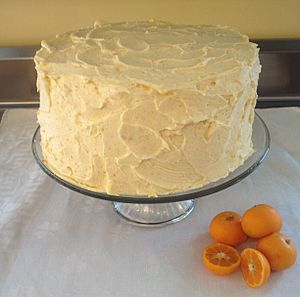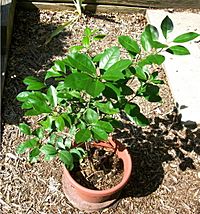Calamansi facts for kids
Quick facts for kids CalamansiCitrus × microcarpa |
|
|---|---|
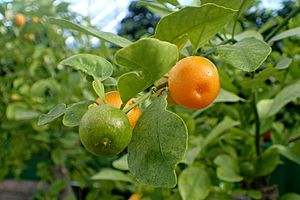 |
|
 |
|
| Scientific classification | |
| Kingdom: | |
| (unranked): | |
| (unranked): | |
| (unranked): | |
| Order: | |
| Family: | |
| Genus: | |
| Species: |
C. microcarpa
|
| Binomial name | |
| Citrus × microcarpa (Bunge) Wijnands
|
|
| Synonyms | |
|
Citrus mitis |
|
Calamansi (also called calamondin or Philippine lime) is a small, sour citrus fruit. It's a very important crop, especially in the Philippines. This fruit originally comes from Southeast Asia (like the Philippines and Indonesia) and parts of East Asia (like southern China and Taiwan).
Filipino cooking uses calamansi all the time! It's super sour, so people use it in sauces, drinks, and many dishes. You can also find calamansi in Malaysian and Indonesian foods. Calamansi is a natural mix, or hybrid, between a kumquat and another type of mandarin orange.
Contents
What is Calamansi Called?
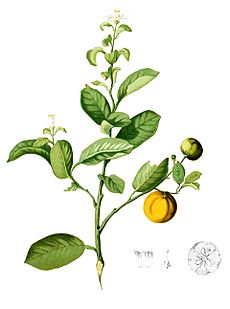
The most common name for this fruit in the Philippines is kalamansi. In some parts of the United States, like Florida, it's known as "calamondin." This name came from the time when the Philippines was under American rule.
Other English names for calamansi include Philippine lime, calamondin orange, golden lime, and Philippine lemon.
What Does Calamansi Look Like?
Calamansi plants are shrubs or small trees. They usually grow to be about 3 to 6 meters (10 to 20 feet) tall. Their leaves have unique wing-like parts on their stems, and their flowers are white or purplish.
The fruit itself looks like a small, round lime. It's usually about 2.5 to 3.5 centimeters (1 to 1.4 inches) wide. When it's ripe, the inside pulp and juice are orange, like a tangerine. The peel is very thin and also orange. Each fruit usually has 8 to 12 seeds inside.
Striped Calamansi
There's also a special kind of calamansi that has green stripes on its yellow fruit. This is a natural mutation, meaning a slight change in the plant's genes.
How is Calamansi Used?
Cooking and Drinks

Calamansi fruits are very sour, so people often use them for cooking or to make preserves. The small citrus fruit adds a special flavor to many foods and drinks. Even though the fruit is sour, its peel can be sweet. You can even make calamansi marmalade, just like orange marmalade. Like other citrus fruits, calamansi is full of vitamin C, which is good for you!
You can freeze whole calamansi fruits and use them like ice cubes in drinks. They are great in tea, soft drinks, water, and even cocktails. The juice can be used instead of regular lime juice. If you crush the whole fruit, you get a flavorful drink similar to lemonade. Some people even make a liqueur by mixing whole calamansi fruits with vodka and sugar.
Calamansi in the Philippines
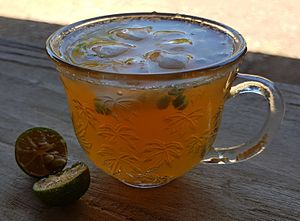
In Filipino cuisine, calamansi juice is used to marinate fish, chicken, and pork. It's also an important ingredient in dishes like sinigang (a sour soup) and kinilaw (raw fish marinated in vinegar or citrus).
It's very common as a condiment for dishes like pancit (noodles) or lugaw (rice porridge). It's also the main ingredient in sawsawan, a popular dipping sauce made with calamansi juice and soy sauce or fish sauce. This dip is perfect for fish, spring rolls, and dumplings. Calamansi juice is also a popular Filipino drink, similar to lemonade.
Calamansi in Other Places
Indonesia
In northern Indonesia, especially around North Sulawesi, calamansi is used in local recipes. People often sprinkle the juice on fish before cooking to remove any "fishy" smell. Kuah asam, a clear fish broth, is also made with calamansi juice.
Florida
In Florida, people use the fully ripe calamansi fruit, which has a more developed flavor. Some say it tastes like apricot, tangerine, lemon, pineapple, and guava all mixed together! The peel is so thin that each fruit must be picked by hand to avoid tearing it. The whole fruit (without stems and seeds) can be used. It's often pureed or juiced for things like calamondin cake, marmalade, and jam. The peels can even be dried and used as a special seasoning with salt and sugar. Calamondin cakes were very popular in Florida from the 1920s to the 1950s.
Many Floridians who have a calamansi tree in their yard use the juice to make a refreshing summer drink, similar to lemonade or limeade. Its unique sour taste is great for quenching thirst. It can also be used on fish and seafood, or anywhere else you would use a sour citrus fruit.
Growing Calamansi
The Philippines is the main country that grows calamansi. Most of it is grown for its juice, which is sent to countries like the United States, Japan, South Korea, Canada, and Hong Kong. The Philippines exports a huge amount of calamansi juice each year, between 160,000 and 190,000 metric tons!
Major areas where calamansi is grown in the Philippines include the Southwestern Tagalog Region, Central Luzon, and the Zamboanga Peninsula. From the Philippines, calamansi cultivation has spread to other parts of Southeast Asia, India, Hawaii, the West Indies, and North and Central America, though on a smaller scale.
In warmer parts of North America, calamansi is often grown as an ornamental plant in gardens or in pots on terraces and patios. The plant looks especially pretty when it has fruit on it.
Calamansi plants don't like long or very cold weather. So, outdoors, they can only grow in tropical or warm climates. In colder places, people bring their potted calamansi plants inside a greenhouse or as a houseplant during the winter.
In the United Kingdom, this plant has even won an award called the Royal Horticultural Society's Award of Garden Merit in 2017, showing how beautiful it is.
Images for kids
See also
 In Spanish: Calamondina para niños
In Spanish: Calamondina para niños




